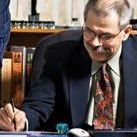
Biography
- Research Interests
- Theoretical and computational chemistry
- Hometown
- Dresher PA
- Home Country
- USA
- Languages
- Italian, Spanish
Born in Mezzanego (GE) Italy. Became a US citizen in 2011
Graduated from the University of Massachusetts Lowell with a B.S. in chemistry 1992
Graduated from Yale University with a Ph.D. in physical chemistry 1996
Postdoctoral fellow at The University of Rhode Island, under Dr. D. L. Freeman 1996 - 1998
Started working at Beaver College, now Arcadia University, in September of 1998
Publications
Classical and quantum simulations of a lithium ion solvated by a mixed Stockmayer cluster
Chem. Phys. Lett.
Author
1970
An Ergodic measure for Diffusion Monte Carlo ground state wavefunctions: Application to a hydrogen cluster with an isotopic impurity
Chem. Phys. Lett.
Author
1970
Stochastic Simulations of Clusters: Quantum Methods in Flat and Curved Spaces
CRC press
Author
1970
Research Summary
I have years of experience in developing and implementing quantum methods to study molecular clusters and similar types of condensed matter. Clusters are special states of matter created naturally in extreme low pressure and low temperature environments. Clusters are the seeds of planetary systems, they can be found in nebulas, in interstellar space, and can be created routinely in laboratory settings. The interest in clusters continues to grow as applications emerge in the field of nanotechnology and material science. Could one fabricate a nanoscale rechargeable lithium ion battery? What "solvents" would work? What would the technical advantages be? Aside from the potential engineering applications, scientists are interested in answering more fundamental questions: Why clusters form in the first place? What are their physical, thermodynamic, kinetic and reactive properties like? What are the correct laws of physics that describe and predict best the properties of clusters? This last question turns out to be quite complicated, as the laws of quantum physics do play a role at low temperature, and when the relative masses associated with dynamic degrees of freedom are sufficiently small. In this regard, the quantum theory of molecular aggregates is in its infancy. The laws of physics (i.e. the Schroedinger equation, or the Feynman Path Integral) are well established, but their implementation to molecular matter is extremely challenging.
Media Mentions
- Dr. Curotto Recommended for $70,000 Research Grant on Lithium Ion Batteries
- Stringer ’20, ’21M Sees New Career Possibilities After Chemistry Lab Experience
- Dr. Curotto and Ravin ’21 Publish Co-Authored Article in Chemical Physics Letters
- Arcadia STEM Scholars Thrive With Help From National Science Foundation Program

